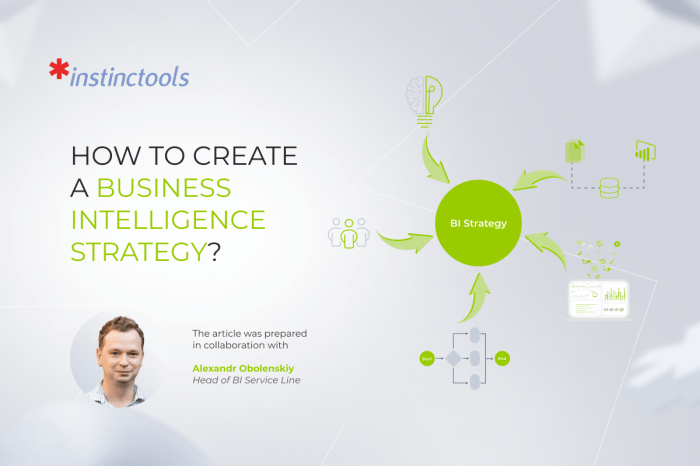BI strategy is crucial for modern businesses to thrive in a data-driven world. Dive into the key components and best practices to develop a robust BI strategy that aligns with your business objectives.
What is a BI strategy?

A Business Intelligence (BI) strategy is a comprehensive plan that Artikels how an organization will leverage data to make informed decisions, improve performance, and gain a competitive advantage in the market. It involves defining objectives, identifying key performance indicators (KPIs), selecting appropriate tools and technologies, and establishing processes for data collection, analysis, and reporting.
Importance of having a well-defined BI strategy
Developing a well-defined BI strategy is crucial for organizations looking to harness the power of data effectively. Some key reasons why having a solid BI strategy is important include:
- Alignment of objectives: A BI strategy helps align data initiatives with organizational goals, ensuring that data analytics efforts are focused on areas that drive business value.
- Improved decision-making: By providing access to timely and relevant data insights, a BI strategy enables decision-makers to make informed and data-driven decisions.
- Competitive advantage: Organizations with a well-defined BI strategy are better positioned to identify market trends, customer preferences, and operational efficiencies, giving them a competitive edge.
Benefits of implementing a BI strategy
Implementing a BI strategy can offer numerous benefits to organizations, such as:
- Enhanced data visibility: A BI strategy provides stakeholders with greater visibility into data, allowing them to uncover valuable insights and trends that may have otherwise gone unnoticed.
- Increased operational efficiency: By streamlining data processes and automating reporting, a BI strategy can help improve operational efficiency and reduce manual effort.
- Empowered decision-making: With access to accurate and real-time data, decision-makers can make more informed choices that drive business growth and performance.
- Scalability and flexibility: A well-defined BI strategy can adapt to changing business needs and scale as the organization grows, ensuring continued relevance and effectiveness.
Components of a BI strategy
When it comes to developing a successful Business Intelligence (BI) strategy, there are key components that play a crucial role in its effectiveness. These components help organizations harness the power of data to make informed decisions and drive business growth.
Data Quality
Data quality is a fundamental component of any BI strategy. High-quality data ensures that the insights derived from BI tools are accurate and reliable. Poor data quality can lead to misleading conclusions and impact the overall effectiveness of the BI strategy. Organizations must invest in data governance practices, data cleansing, and data validation processes to maintain data quality.
Analytics Tools, BI strategy
Analytics tools are essential components of a BI strategy as they enable organizations to analyze and visualize data to uncover valuable insights. These tools help in identifying trends, patterns, and correlations within the data, allowing businesses to make data-driven decisions. From basic reporting tools to advanced analytics platforms, the right set of analytics tools can empower organizations to extract maximum value from their data.
Developing a BI strategy

Developing a Business Intelligence (BI) strategy involves a systematic approach to leveraging data and analytics to drive business decisions and achieve organizational goals. Below are the steps involved in creating a BI strategy along with best practices for success and aligning business goals.
Steps in Creating a BI Strategy
- Define Business Objectives: Clearly Artikel the specific goals and objectives that the BI strategy aims to support.
- Assess Current State: Evaluate existing data sources, infrastructure, and analytics capabilities to identify gaps and opportunities for improvement.
- Identify Key Performance Indicators (KPIs): Determine the metrics that will measure progress towards achieving the defined business objectives.
- Develop Data Governance Framework: Establish data governance policies and procedures to ensure data quality, security, and compliance.
- Select BI Tools and Technologies: Choose the appropriate tools and technologies that align with the organization’s needs and capabilities.
- Create Implementation Roadmap: Develop a detailed plan outlining the steps, resources, and timeline for implementing the BI strategy.
- Monitor and Evaluate: Continuously monitor the performance of the BI strategy, analyze results, and make adjustments as needed to drive continuous improvement.
Best Practices for Developing a Successful BI Strategy
- Align BI Strategy with Business Objectives: Ensure that the BI strategy directly supports the organization’s overall goals and objectives.
- Engage Stakeholders: Involve key stakeholders from different business units in the development process to ensure alignment and buy-in.
- Focus on Data Quality: Prioritize data quality initiatives to ensure that the insights derived from BI are accurate and reliable.
- Promote Data Literacy: Invest in training programs to enhance data literacy across the organization and empower employees to make data-driven decisions.
- Encourage Collaboration: Foster a culture of collaboration between business and IT teams to ensure that BI solutions meet the needs of end-users.
Aligning Business Goals with a BI Strategy
- Understand Business Objectives: Gain a deep understanding of the organization’s goals and objectives to align the BI strategy accordingly.
- Define Key Metrics: Determine the key performance indicators (KPIs) that will measure progress towards achieving the business goals.
- Establish Data Governance: Implement data governance practices to ensure that data used in BI aligns with business objectives and is accurate and secure.
- Continuous Alignment: Regularly review and adjust the BI strategy to ensure ongoing alignment with evolving business goals and market conditions.
Implementing a BI Strategy

Implementing a Business Intelligence (BI) strategy within an organization involves a series of steps to ensure successful integration and utilization of BI tools and technologies. This process is crucial for harnessing data-driven insights to drive business decisions and achieve organizational goals.
Establish Clear Objectives and Goals
When implementing a BI strategy, it is essential to define clear objectives and goals that align with the organization’s overall vision and mission. This step helps in setting a direction for the BI implementation process and ensures that all efforts are focused on achieving specific outcomes.
- Define key performance indicators (KPIs) to measure the success of the BI strategy.
- Align BI initiatives with business objectives to drive value and ROI.
- Communicate objectives and goals effectively across all levels of the organization.
Build a Strong Data Foundation
One of the critical components of implementing a BI strategy is to establish a strong data foundation. This involves ensuring data quality, integrity, and accessibility for accurate reporting and analysis.
- Centralize data sources and establish data governance practices.
- Implement data quality processes to clean and standardize data for analysis.
- Ensure data security and compliance with regulations to protect sensitive information.
Deploy BI Tools and Technologies
Once the objectives are defined and data foundation is in place, the next step is to deploy BI tools and technologies that enable data visualization, reporting, and analysis to extract actionable insights.
- Choose the right BI tools that align with the organization’s requirements and capabilities.
- Train employees on how to use BI tools effectively to derive insights from data.
- Integrate BI solutions with existing systems for seamless data flow and analysis.
Monitor Performance and Iteratively Improve
Continuous monitoring of BI initiatives and performance is crucial for identifying areas of improvement and optimizing the BI strategy over time. This iterative approach helps in maximizing the value derived from BI investments.
- Track KPIs and metrics to measure the impact of BI on business outcomes.
- Gather feedback from users to identify pain points and areas for enhancement.
- Implement changes and updates based on feedback to improve BI effectiveness.
In conclusion, a well-defined BI strategy is the cornerstone of data-driven decision-making. By aligning business goals with your BI strategy, you can unlock valuable insights and drive sustainable growth for your organization.
When it comes to BI reporting software , businesses need a reliable tool to analyze and visualize data efficiently. This software is crucial for making informed decisions based on accurate insights.
For BI for small business , affordability and ease of use are key factors. Small businesses can benefit from BI tools tailored to their specific needs, helping them compete with larger enterprises.
Utilizing Visual analytics is essential for businesses to interpret complex data through interactive visualizations. This approach enhances data comprehension and facilitates better decision-making processes.




